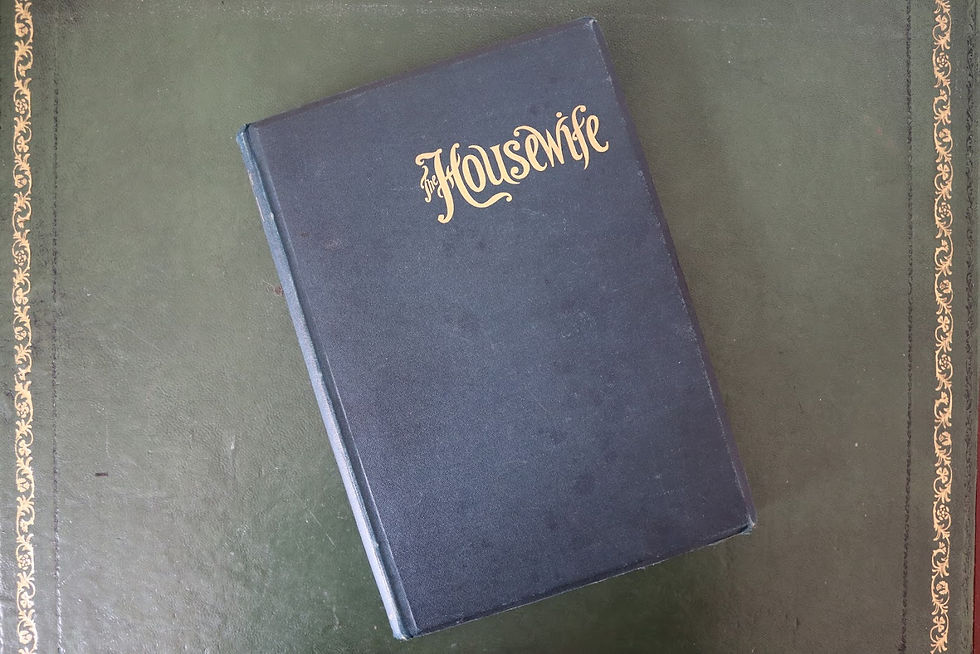Patchwork Advice from a Victorian Periodical
- Aisha

- Jan 15, 2024
- 4 min read
Updated: Apr 15, 2025
Hello darlings!
I bought this edition of 'The Housewife' from eBay some time ago. It's a Victorian periodical from the year 1886, so every magazine from every month of the year has been compiled, often with a similar pattern of articles.

One page caught my eye; an an article on patchwork, despite having never tried patchwork myself. It's one of those disciplines that I really want to try, but there are so many other projects I want to get to first- one day! As one article says:
'"A quilt? Oh no; I couldn't possibly make a quilt, it takes such a time!"
This is the cry one sometimes hears from small throats; and certainly at first sight a quilt does seem rather a formidable undertaking...'
(This article was written by Bertram Emmelyn; the article that this blog post is structured around was written by Ruth Noel.)

'Before commencing work, it saves time and labour, together with chances of error in making these combined models, to have stiff cardboard or tin plates of each, by which to cut the patterns, or it will be impossible to faithfully preserve the exact shapes.'

'Some ingenious persons get a carpenter to cut thin, but strong, blocks of wood to the desired shapes, and these form excellent guides to the worker. The best foundation for patches will be found in old envelopes and old letters, which are quite stiff enough to tack your scraps upon. Some people use cards and brown paper.'
There's actually a lovely example of a quilt being constructed using old letters at St. Fagans museum.

You can actually see the writing on the back of the quilt pieces!

'The method of doing your work is as follows: Having procured your shapes, follow each design, and cut them carefully out in paper. Then, having decided on the arrangement of the different shades, cover each shape very neatly, and one by one tack the covering on with a very fine needle and cotton, so as to make the least possible impression on the material.'

'It is a good plan to make a large quantity of shapes before commencing work, as they can be more carefully arranged, and a general idea of their future appearance will thus be gained. The sewing together is done with cotton, for cotton materials; with fine silk to suit the colours of satin, velvet and silk patchwork, or else with fine white or black sewing silk.'

'Still, it is both safer and better to use coloured cotton for cotton materials, and coloured silk for woollen, velvet, satin and silk patchwork. The utmost perfection of stitch is absolutely necessary, as if the needlework becomes visible, the work is spoiled. Therefore, it is needful to use coloured cotton or silk for coloured goods.'
An earlier article by Mary Emerson has some humorous observations and lovely patchwork patterns.

‘As it is the fashion just now to borrow from Americans, we will borrow some of their patchwork patterns. They probably got them from us originally, but as they have made the work much more popular than it is with us, we will not assert our right to the designs.’

‘A favourite amusement in the country is what is known as “a quilting,” where a number of young ladies are invited to spend the day, and help quilt– as many as twelve working together. This is a capital opportunity for conversation and social gossip. The work is supposed to be finished, and the room cleared for an evening party, when the gentlemen are permitted to put in an appearance.’

Back to the article by Ruth Noel!
'While making patchwork, think for a moment of the colours that are to be seen in stained glass windows. There you will see soft tints harmonising or contrasting, and yet mingling so that monotony is avoided. All is soft, easy to the eye, and arranged so as to be light or dark, warm or cool in colour, yet full of delicate blendings that never mar the perfect finish.'

'It seems to me patchwork is so beautiful, that, whether it be produced in cotton or velvet, it deserves artistic arrangement. Not merely the careful following of the blocks, but their reproduction, in a manner that makes one forget they are mere patches, and regard them as a beautiful mosaic work wherein not one marble outshines another's excellence; all blended as rainbow blendings, soft and easy to the sight, and pleasing to all beholders.'

'For, what is more teasing to one compelled to remain in bed all day, or to be headache-bound among drawing-room cushions, than to see a persistent wheel-within-a-wheel of two particular colours whirling before your eyes, or to be able to count the bars of glaring ladders leading to heights of bewilderment, or, to watch little tilted-up blocks of cream-colour starting up like figures in arithmetic all ready to be cast, just when you most desire mental rest; or long lines of striped rays darting out from central spots that intoxicate you with giddiness! These must be avoided, and the accompanying designs afford excellent opportunities for the judicious and rich blending of colours.'

'Methodical people sort their pieces into dark, light, and half tints, to begin with, and keep their patches made up in the same order. This is an excellent plan, helping you to find the exact tone of colour you require. Clever patchworkers make a bag in which to collect all scraps, and such a receptacle is very necessary.'
~
Did you like this form of post? There's a load of articles in the housewife along the same vein, from keeping chickens to cookery! If you would like to know anything, drop a message and I can see if there's any Victorian advice in this periodical!
Until next time,
Aisha x



Comments